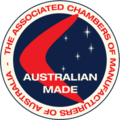Australian Made logo
The Australian Made, Australian Grown trade mark logo signifies products whose ingredients or production mostly originate from Australia. The triangular green-and-gold logo, featuring a kangaroo, was introduced in 1986. The Australian Made, Australian Grown logo is administered by Australian Made Campaign Limited (AMCL).[1][2] The logo is accompanied by one of the following phrases: Australian Made, Australian Grown, or Product of Australia.
History
In the 1930s a group of businesses gathered up and created a media campaign to publicise Australian made products.

In 1961, a national "Buy Australian" campaign was introduced by the Associated Chambers of Manufacturers of Australia (ACMA). The campaign was launched by Prime Minister Robert Menzies in May 1961.[3] The campaign was colloquially known at the time as Operation Boomerang.[4] About the same time, the campaign introduced an emblem featuring a red boomerang on a blue circular background depicting the Southern Cross.[5][6]
A new green-and-gold coloured triangular-shaped "Australian Made" logo featuring a stylised kangaroo was introduced as part of the "Australian Made" campaign launched by Prime Minister Bob Hawke on 31 August 1986.[7][8] The logo was designed by Ken Cato.[9]
In 2002, the Federal Government transferred ownership of the logo to Australian Made Campaign Limited (AMCL), a not-for-profit public company established in 1999. The Australian Made, Australian Grown logo is currently now administered by AMCL.[10]
From 1 July 2016, the Australian Government has changed food labelling laws to add a bar showing the percentage of Australian ingredients for any product made in Australia. Any business in Australia will have from 1 July 2016 to 30 June 2018 to comply with the new rule.[11]
Concept
Local purchasing is a preference to buy locally produced goods and services over those produced more distantly. In the context of the Australian Made and Australian Grown brands the purpose being to encourage consumers to exercise their preference for buying Australian, and promoting Australian products in Australia and markets around the world.[12] The Australian Made logo represents a country of origin label.
Another non-profit organisation within Australia is Ausbuy, that has a similar objective to promote Australian made products. Many countries have similar buy local initiatives such as Made in USA.
A business launched in 2009 BuyAustralianMade promotes Australian made products, Australian grown produce and Australian delivered services. BuyAustralianMade's philosophy is that if one does not know what is made in Australia and where and how to buy it, they will not promote the product otherwise.
The cost of using the Australian Made logo is between $300 and $25,000 depending on sales revenue.[13]
Variations
The logo has different variations on the text 'Australian made', depending on what in a certain product has originated from Australia. Here are the examples with their definitions:
- The definition for Australian Made means that the product is substantially transformed in Australia. Cost of manufacturing in Australia no longer considered.
- The definition used for Product of Australia requires that the product has all, or nearly all, of the manufacturing or processing carried out in Australia and that all of the products significant ingredients come from Australia.
- The definition for Australian Grown is that each significant ingredient has been grown in Australia and all or virtually all of the production processes have occurred in Australia.
See also
- Ausbuy – an Australian local purchasing business alliance (1991–2016)
- Products manufactured in Australia
- Australia Made Preference League (1920s)
References
- "Frequently asked questions". Website. Australian Government - Austrade. 2011. Retrieved 3 April 2011.
- "The official site of Australian Made". Australian Made Campaign Limited (AMCL).
- "Industry's Drive". The Canberra Times. 35, (9, 915). Australian Capital Territory, Australia. 18 May 1961. p. 1. Retrieved 12 July 2020 – via National Library of Australia.CS1 maint: extra punctuation (link)
- "Boost for Goods". The Cumberland Argus. New South Wales, Australia. 26 July 1961. p. 2. Retrieved 12 July 2020 – via National Library of Australia.
- "Diamond Jubilee of ACMA Australian Made Campaign has Five Objectives". The Canberra Times. 38, (10, 703). Australian Capital Territory, Australia. 26 November 1963. p. 33. Retrieved 12 July 2020 – via National Library of Australia.CS1 maint: extra punctuation (link)
- "The Australian Made, Australian Grown Logo" (PDF). Australian Made Campaign Limited (AMCL). Retrieved 12 July 2020.
- "Hawke says buy local". The Canberra Times. 60, (18, 597). Australian Capital Territory, Australia. 1 September 1986. p. 7. Retrieved 12 July 2020 – via National Library of Australia.CS1 maint: extra punctuation (link)
- "All Australians urged to 'buy Oz' goods". The Canberra Times. 60, (18, 516). Australian Capital Territory, Australia. 12 June 1986. p. 15. Retrieved 12 July 2020 – via National Library of Australia.CS1 maint: extra punctuation (link)
- "The Australian Made, Australian Grown Logo" (PDF). Australian Made Campaign Limited (AMCL). Retrieved 12 July 2020.
- "About Australian Made". Australian Made Campaign Limited (AMCL). Retrieved 12 July 2020.
- The Australian Made Campaign (18 April 2016). "Changes to food labelling laws are here - The Australian Made Campaign". australianmade.com.au. Retrieved 28 June 2017.
- "Australian Made logo making a comeback". Website. Dynamic Business. 5 March 2010. Retrieved 3 April 2011.
- "How much does it cost?". Website. Australian Made. 7 July 2020. Retrieved 7 July 2020.